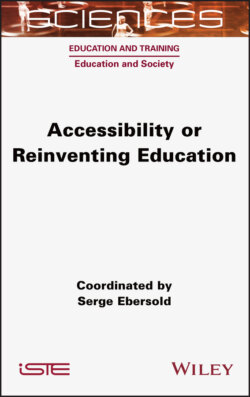Accessibility or Reinventing Education

Реклама. ООО «ЛитРес», ИНН: 7719571260.
Оглавление
Группа авторов. Accessibility or Reinventing Education
Table of Contents
List of Tables
List of Illustrations
Guide
Pages
Accessibility or Reinventing Education
Introduction
I.1. The school, a vector of social protection because of its accessibility
I.2. Accessibility: an imperative legitimized by a dedicated institutional framework
I.3. An imperative subjected to orchestration by institutions
I.4. An imperative promoting new normative standards
I.5. References
1. The Accessibility Imperative: Outlines and Implications
1.1. Introduction
1.2. Accessibility, or school as a social protection vector
1.3. Accessibility, an imperative focused on the ergonomization of practices
1.3.1. Preventing vulnerabilities through a universal approach to accessibility
1.3.2. An integrated approach to accessibility targeting the fight against educational failure
1.3.3. A corrective approach to accessibility aimed at restoring school legitimacy
1.4. An ergonomization of practices related to the fight against institutional discrimination
1.5. Accessibility, or the advent of new forms of normativity
1.6. Conclusion
1.7. References
2. Inclusion and Accessibility: 50 Years of Change1
2.1. Introduction
2.2. Developing a continuum of support for promoting accessible learning environments
2.3. Developing accessible learning environments; results of international case studies
2.3.1. Recognizing and planning for diversity
2.3.2. Using evaluation for improvement
2.3.3. Professional development of staff
2.3.4. External support services
2.3.5. Within-school services
2.3.6. Co-operation between schools
2.3.7. Parental and community involvement
2.3.8. Whole-school development organization and management strategies
2.3.9. Curriculum development
2.3.10. Classroom organization
2.4. Promoting accountable education systems supporting accessible learning environments
2.5. Conclusion
2.6. References
3. Accessibility Requirements and Evaluation Policies
3.1. Introduction
3.2. New governance of education systems based on performance and social justice
3.3. Evaluation: intellectual movements and political discourse
3.4. Assessment policies and the accessibility imperative
3.5. Conclusion
3.6. References
4. Educational Accessibility: A Catalyst for Innovative Practices
4.1. Introduction
4.2. The heuristics of innovative teaching practices
4.2.1. The catalytic potential of innovative forces and practices
4.3. School environments and the pedagogical imperative of accessibility
4.3.1. The grouping of learners
4.3.2. The grouping of professionals
4.3.3. The planning of learning and its collocation over time
4.3.4. Pedagogies and assessment practices
4.4. Collaboration and accessibility: beyond “mainstream” and “special”
4.4.1. An emergency condition
4.5. References
5. School Form and Pedagogical and Didactic Accessibilization
5.1. Introduction
5.2. Characteristics of the school form
5.3. Practical ways of making school situations more accessible. 5.3.1. Study aid gestures
5.3.2. The use of digital tools
5.3.3. Pedagogical and didactic adaptations
5.4. Elements for reflection on a model of analysis of teachers’ gestures and postures with a view to accessibilization
5.5. Conclusion
5.6. References
6. The Contribution of ICT to Accessible Learning Environments
6.1. Introduction
6.2. Clarifications on the terminology
6.3. ICT to develop accessible learning environments – more than a purchasing decision
6.4. Embedding ICT in educational organizations to promote accessible learning environments
6.5. The transformation of teaching
6.6. Learners becoming accountable for their learning
6.7. Conclusion
6.8. References
7. The Reconfiguration of the Teaching Profession within the Dynamics of Accessibility
7.1. Introduction
7.2. From the “special” professional to the educational accessibility professional
7.3. A new professionalism that reconfigures teaching legitimacy
7.4. New dimensions of the profession
7.5. Teachers’ requests and concerns
7.6. Conclusion: new issues, new questions
7.7. References
8. Modes of Accessibilization and the Redefinition of Schooling in Accessibility
8.1. Introduction
8.2. Accessibility as a source of democratization through compensatory policies?
8.3. Accessibility as a source of efficiency and equity, in the name of combating exclusion?
8.4. Accessibility as a source of inclusion, to maximize opportunities?
8.4.1. A profusion of categories and devices
8.4.2. An individualizing and essentializing reading of school productions
8.4.3. Transformation of the curriculum and school culture
8.5. Conclusion
8.6. References
9. Externalized Teaching Units: A Tool for Making School Institutions More Accessible?
9.1. Introduction
9.2. Making the school environment more accessible through subcontracting
9.3. Hierarchical access to the facility
9.4. Conclusion
9.5. References
10. Social Figures of Allophony, Approaches to Accessibility and Social Inequalities
10.1. Introduction
10.2. Two approaches to accessibility: a dual staging of school legitimacy
10.3. The principles of justice underlying the various approaches to school accessibility
10.4. Conclusion: accessibilization strategies as a source of educational inequalities
10.5. References
11. The Grammar of Accessibility
11.1. Introduction
11.2. Access as social visibility
11.2.1. Access as “taking part”
11.2.2. Access as “being part”
11.2.3. Access as “acting on”
11.2.4. Access as a “sense of existing”
11.3. Accessibility as social legibility
11.3.1. A finalist approach to the concept of accessibility
11.3.2. A procedural approach to the concept of accessibility
Box 11.1. Criteria for digital accessibility (source: Secrétariat général pour la modernisation de l’action publique – General Secretariat for the Modernization of Public Action)
11.3.3. An ergonomic approach to the concept of accessibility
11.4. The concept of accessibilization as social legitimacy
11.4.1. Accessibilization refers to the institutional legitimization of facilities
11.4.2. Accessibilization builds upon the legitimization of the schooling process
11.4.3. Accessibilization results from the driving force of conventions
11.4.4. Accessibilization is correlated with agents’ art of creating
11.5. Conclusion
11.6. References
List of Authors
Index. A
B, C
D
E
F, G
H, I
J, L
M, N, O
P
R
S
T
WILEY END USER LICENSE AGREEMENT
Отрывок из книги
Education and Training, Field Director – Jean-Marc Labat
.....
OECD (2014). Talis 2013 Results: An International Perspective on Teaching and Learning. OECD, Paris.
OECD (2019). Talis 2018 Results: Teachers and School Leaders as Lifelong Learners. OECD, Paris.
.....